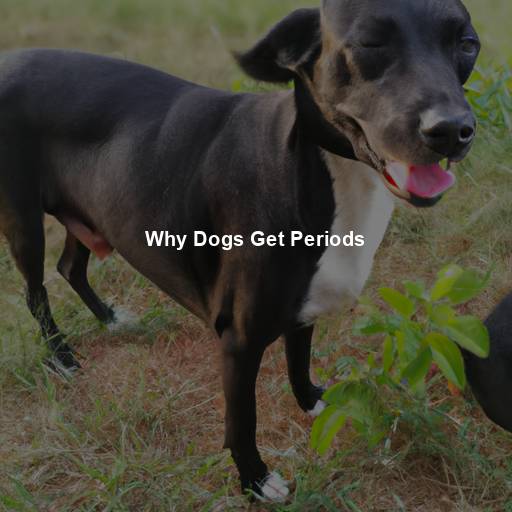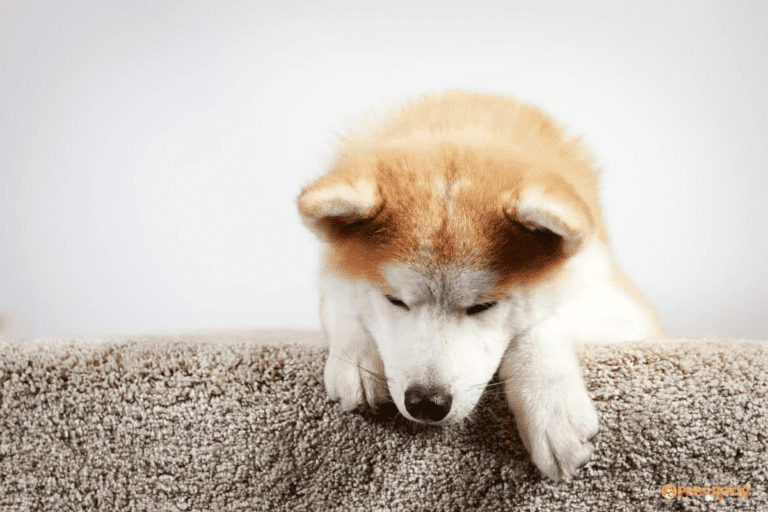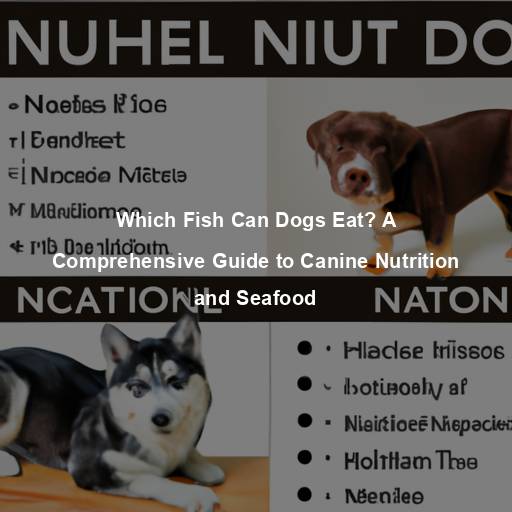Why Dogs Get Periods
Last Updated on November 1, 2023 by Evan
Contents
- 1 Understanding the Reproductive Cycle of Female Dogs
- 1.1 The Estrous Cycle: A Journey through the Reproductive Phases
- 1.2 The Purpose of the Estrous Cycle
- 1.3 Addressing Misconceptions and Concerns
- 1.4 Hormonal Changes during the Estrous Cycle
- 1.5 Factors Influencing the Estrous Cycle
- 1.6 Health Considerations and Spaying
- 1.7 Supporting Your Female Dog through Her Estrous Cycle
- 1.8 Celebrating the Wonders of the Estrous Cycle
- 2 FAQs: Why Dogs Get Periods
- 2.1 Q: Do dogs really get periods?
- 2.2 Q: How often do dogs have periods?
- 2.3 Q: What signs indicate that a dog is having her period?
- 2.4 Q: Are dogs fertile during their periods?
- 2.5 Q: Should I change my dog’s routine during her period?
- 2.6 Q: Can dogs experience discomfort or pain during their periods?
- 2.7 Q: Can dogs use period products like pads or tampons?
- 2.8 Q: Can spaying prevent dogs from having periods?
- 2.9 Q: Are there any health concerns related to a dog’s period?
- 2.10 Q: Can I bathe my dog during her period?
Understanding the Reproductive Cycle of Female Dogs
Dogs, those incredible beings that weave a tapestry of companionship and delight in our lives, possess an enigmatic and perplexing reproductive cycle that often leaves us inquisitive. Female dogs, akin to their human counterparts, bear witness to a fascinating journey of periods, or what we commonly term as “heat”. As pet owners, it becomes imperative for us to unravel the intricacies of their reproductive saga, understanding the motives that drive their cycles and venturing into the labyrinth of stages that manifest within. Join us as we embark on an expedition, exploring the enigma of why dogs get periods and comprehending the multitudes of their reproductive symphony.
The Estrous Cycle: A Journey through the Reproductive Phases
Unlike humans, female dogs do not menstruate, but rather go through a process called the estrous cycle. This cycle consists of four distinct phases: proestrus, estrus, diestrus, and anestrus. Each phase plays a crucial role in the reproductive abilities of a female dog.
Proestrus: The Prelude to Fertility
During the proestrus phase, which lasts approximately 9 to 10 days, female dogs may experience changes in their behavior and physical appearance. One of the noticeable signs during this phase is the presence of vaginal bleeding, often referred to as a dog’s period. However, it is important to note that this bleeding is not the same as a human menstrual cycle.
During the enigmatic phase of proestrus, wondrous biological transformations take place within the female canine’s body, serving as a prelude to the mystical dance of potential mating. A captivating symphony of hormonal fluctuations unveils the release of beguiling pheromones, orchestrating a tantalizing allure that beckons suitors from afar. As if caught in a trance, the female dog’s charisma amplifies, revealing telltale signs such as a delicate swelling of the vulva and a heightened need for frequent urination that augments this enigmatic phenomenon.
Estrus: The Fertile Window
Following proestrus, the estrus phase begins. This is the period during which female dogs are fertile and can conceive. The duration of estrus may vary, typically lasting between 5 to 13 days, but it can differ among individual dogs.
During the perplexing stage of estrus, the puzzling phenomenon of proestrus bleeding may experience an unexpected burst of reduction or even a bewildering halt altogether. While this may leave one perplexed, rest assured that the swollen vulva remains a constant reminder of this enigmatic phase, as the female dog becomes increasingly open to the companionship of male canines. It is during this intricate period that the perplexing puzzle of reproduction finds its optimal moment, as the female dog’s elusive eggs are gracefully released from their secretive home within the ovaries, awaiting the possibility of a captivating fertilization dance.
Diestrus: The Luteal Phase
Once a female dog goes through the heat cycle, the mysterious diestrus phase takes over, bringing with it a wave of hormonal activity. This enigmatic phase is the starting point for the luteal phase, where a series of intricate changes lay the groundwork for a possible pregnancy. If the dog is blessed with the gift of conception, diestrus puts on a show for approximately 60 days, guiding and nurturing the new life within. However, if nature decides otherwise and pregnancy remains elusive, diestrus may bid adieu after a perplexingly short stay of just 9 to 10 days.
In the intricate dance of a female dog’s reproductive cycle, diestrus takes center stage, filled with anticipation and mystery. As hormones continue to surge, the body sets the stage, weaving a tapestry of complex changes. Amidst this enigmatic ballet, behavioral shifts may emerge, adding a touch of intrigue to the unfolding story. However, if the elusive seed of life fails to find its home, the body gracefully readies itself for the next enigmatic act, brimming with possibilities and secrets yet to be unveiled.
Anestrus: The Resting Phase
Following diestrus, the final phase of the estrous cycle is anestrus. This is a resting phase during which the female dog’s reproductive system is inactive. Anestrus can last for several months, typically ranging from 4 to 5 months, before the cycle restarts with proestrus.
The enigma of anestrus surrounds the enigmatic world of the female dog’s intricate hormonal dance. Like a mysterious cosmic symphony, during this perplexing phase, her hormones retreat into the shadows, reverting to their primal baseline. A momentary pause envelops her reproductive system, a silence in the tumultuous cycle, before the enigmatic riddle of fertility begins anew, shrouded in the veil of uncertainty.
The Purpose of the Estrous Cycle
As we embark on this fascinating journey through the intricacies of the estrous cycle, we unravel the enigma behind its existence in the female canine realm. We find ourselves swirling amidst a whirlwind of perplexity, seeking to comprehend the driving force that propels this intricate reproductive symphony. Behold, dear readers, the ultimate purpose unfurls before us: the very essence of the estrous cycle lies in its remarkable ability to orchestrate the dance of reproduction, ensuring the survival and perpetuation of the canid lineage.
In the tangled world of canine courtship, the intricate dance of hormones and physical transformations unveils a mesmerizing spectacle. In the untamed wilderness, female dogs harness the power of scent, releasing enigmatic pheromones that ignite a captivating frenzy among potential suitors. With an astonishing display of nature’s prowess, these females showcase their peak fertility, enticing male dogs to vie for the chance to create the next generation of pups. It is a primal game of chance and destiny, where the interplay of attraction and reproduction unfolds amidst the mysteries of the animal kingdom.
The fascinating world of our beloved canines never ceases to amaze! Despite their distance from the wild, our domesticated dogs still dance to the ancient rhythms of nature. Within their intricate biology lies the captivating estrous cycle, a remarkable process that orchestrates the perfect timing for breeding. This wondrous cycle allows female dogs to gracefully embrace their fertile window, ensuring the best possible outcome for future generations of furry companions.
Addressing Misconceptions and Concerns
It is not uncommon for pet owners to have concerns or misconceptions about their female dog’s reproductive cycle. Let’s address some of the common questions and provide clarification on these topics.
Can Female Dogs Get Pregnant During Their Period?
There seems to be a common misconception surrounding the reproductive cycle of female dogs. Contrary to popular belief, it’s important to clarify that pregnancy is not possible during the bleeding phase of proestrus. The purpose of this bleeding is to indicate that the female dog is gearing up for potential mating and serves as a precursor to the fertile phase of estrus. It is during estrus that the window of opportunity for conception opens up if the female dog engages in mating with a male dog.
Should I Prevent My Female Dog from Going through Her Cycle?
Deciding whether or not to spay a female dog is a deeply personal decision that warrants careful consideration and consultation with a veterinarian. On one hand, spaying can effectively eliminate the possibility of unplanned canine pregnancies while reducing the likelihood of certain reproductive ailments. However, it is imperative to thoroughly weigh the potential health advantages and drawbacks tied to this surgical procedure.
How Can I Manage My Female Dog’s Cycle?
Managing a female dog’s reproductive cycle can be challenging, especially during estrus when she is receptive to male dogs. There are a few options to consider:
As a responsible pet owner, it is important to keep your female dog indoors during her estrus cycle. This not only reduces the possibility of unexpected breeding but also keeps her safe and secure. By taking this precaution, you can ensure her well-being and avoid any unplanned surprises.
Keeping your home tidy and free from unwelcome stains can be a perplexing challenge for pet owners during their furry friend’s proestrus stage. Luckily, there are innovative solutions available, such as specially crafted doggie diapers or pants, that can provide bursts of protection and much-needed relief. By incorporating these protective garments into your routine, you can navigate the intricacies of managing your pet’s bleeding with ease, while maintaining a clean and serene environment.
- Consider Hormonal Treatments: Discussing hormonal treatments with a veterinarian is an option for managing your female dog’s reproductive cycle. These treatments can help regulate the cycle and prevent estrus from occurring.
When it comes to handling your female dog’s cycle, seeking guidance from a trusted veterinarian is crucial. This enables you to tailor a management plan that caters specifically to your dog’s unique requirements. By understanding her individual needs, you can navigate this perplexing aspect of pet ownership with confidence and ensure her well-being.
Hormonal Changes during the Estrous Cycle
The estrous cycle in female dogs is primarily regulated by hormones. These hormones play a crucial role in orchestrating the various phases of the reproductive cycle. Let’s explore the hormones involved and their impact on the female dog’s body.
Estrogen: The Key Player
Estrogen, oh the mystical hormone that dances within the enigmatic estrous cycle! As the proestrus phase emerges, behold the surge of estrogen that ignites a symphony of transformations within the female dog’s very being. From the tantalizing swelling of the vulva to the siren’s call that bewitches male suitors, the intricate web of estrogen reveals its bewildering power in this awe-inspiring journey of nature’s design. Join us as we unravel the captivating tale of estrogen’s passionate dance, where perplexity intertwines with the allure of bursting change.
As the cycle progresses, estrogen levels gradually decline during the estrus phase. This decline triggers the release of eggs from the ovaries, allowing for potential fertilization. After estrus, estrogen levels decrease further, leading to diestrus and anestrus.
Progesterone: Preparing for Pregnancy
Another important hormone in the estrous cycle is progesterone. After ovulation occurs during estrus, the levels of progesterone rise. This increase prepares the female dog’s uterus for potential pregnancy. If fertilization occurs, progesterone levels remain elevated, supporting the development of the embryos.
As diestrus sets in, progesterone levels eagerly take the reins to ensure a sturdy foundation for a potential pregnancy. But, alas, if the female dog’s hopes of motherhood are dashed, these same levels will gradually retreat, engulfed by uncertainty, serving as a bittersweet finale to diestrus and unleashing the enigmatic phase known as anestrus.
Factors Influencing the Estrous Cycle
The length and consistency of a female dog’s estrous cycle can be quite enigmatic, influenced by an intricate interplay of multiple factors. Each dog possesses her own unique biological makeup and is susceptible to diverse environmental influences, making it challenging to predict the precise duration and regularity of this cycle. Elucidating the intricate mechanisms that govern these variations proves to be an intriguing and perplexing task for researchers and dog owners alike.
Breed and Size
Different dog breeds and sizes may have variations in the length of their estrous cycle. Smaller breeds tend to have shorter cycles, while larger breeds may have longer ones. It is important to be aware of the typical cycle length for your specific breed when monitoring your female dog’s reproductive health.
Age and Reproductive Maturity
There’s a fascinating twist to the intricate world of female dogs and their estrous cycle – age. Ah, that mystical factor that often holds the reigns to countless mysteries. It’s quite a perplexing journey, you see. Puppies, those adorable bundles of joy, patiently bide their time until they reach sexual maturity, their first estrous cycle awaiting like an elusive gem.
As our furry companions journey through the stages of life, a captivating twist awaits their hormonal patterns. It’s no secret that aging brings forth a whirlwind of surprises, even for our four-legged friends. Brace yourself for the peculiar rollercoaster of irregularities in estrous cycles that await some senior dogs. Should you stumble upon any enigmatic shifts in your beloved pup’s reproductive rhythm, the wise path lies in seeking counsel from a trusted veterinarian.
Environmental Factors
Environmental factors can also influence the timing and regularity of a female dog’s estrous cycle. Factors such as changes in daylight hours, temperature, and the presence of other dogs can impact the onset and duration of the cycle.
Dogs, like humans, are known to have their own peculiar reproductive patterns. Take the enigmatic phenomenon of seasonal estrus cycles for instance, where some furry friends decide to embrace their romantic side only during certain times of the year. This intriguing occurrence tends to be more prevalent among specific breeds hailing from colder corners of the world, adding an extra layer of mystique to their already captivating nature. It’s just another whimsical aspect that distinguishes our canine companions and keeps us pondering about the wonders of nature.
Health Considerations and Spaying
Taking care of your furry companion’s reproductive health is crucial for their holistic welfare. By scheduling routine visits to the vet and closely observing their estrous cycle, you can proactively address any underlying health concerns or irregularities that may arise. Stay informed and ensure your beloved pet’s reproductive system remains in optimal condition.
Pyometra: A Serious Condition
One of the most pressing concerns for dog owners is the ominous threat of pyometra, a perilous infection that targets the uterus of unspayed female dogs. Utterly bewildering in its onset, this formidable condition most commonly emerges during or after the diestrus phase of the estrous cycle. Its potential to jeopardize the very life of our beloved companions demands our unwavering attention.
Signs of pyometra may include vaginal discharge, increased thirst, lethargy, and loss of appetite. If you notice any of these symptoms, it is crucial to seek immediate veterinary attention. Spaying your female dog is the most effective way to prevent pyometra.
Benefits and Considerations of Spaying
Considering the importance of responsible pet ownership, it comes as no surprise that spaying has emerged as a widely-performed surgical intervention. This procedure, involving the removal of a female dog’s uterus and ovaries, serves as an effective means to prevent unplanned litters and protect against the daunting risk of pyometra. Moreover, spaying decreases the likelihood of certain reproductive malignancies, unraveling its paramount significance in ensuring the overall well-being of our beloved canine companions.
When pondering whether or not to spay your female pup, it’s crucial to tread with caution. The act of spaying is a definitive choice that can have far-reaching consequences for her overall well-being. Prioritize an open dialogue about the possible pros and cons of spaying with a trusted veterinarian, enabling you to make an informed decision that takes into account your furry companion’s unique circumstances.
Supporting Your Female Dog through Her Estrous Cycle
For those of us who have the joy and privilege of being pet parents, it is crucial to lend a helping hand to our beloved female dogs during their estrous cycle. By showering them with the utmost care and undivided attention, we can guarantee their ultimate comfort and overall health. It’s a journey that might raise a few eyebrows and leave you puzzled, but fear not – we’ve got you covered with all the information you need to navigate this perplexing phase of your furry friend’s life. Get ready to embark on a rollercoaster ride of emotions and uncertainties as we unveil the secrets to supporting your dog’s well-being during this dainty time.
Maintaining a Safe Environment
In the ever-changing landscape of a female dog’s hormonally charged journey through reproductive cycles, it becomes paramount to create an environment that is not only a sanctuary but also a fortress. This intricate dance of proestrus and estrus phases demands our unwavering attention to ensure the safety and wellbeing of our beloved pets. By meticulously orchestrating a haven within our very own walls or erecting a fortification of sturdy fences, we navigate the treacherous waters of unintentional mating and safeguard against any unforeseen harm that may befall our cherished companions.
Providing Comfort and Hygiene
Female dogs may experience discomfort and increased sensitivity during their reproductive cycle. Providing a comfortable and clean space for your dog to rest is important. Additionally, consider using protective garments, such as doggie diapers or pants, to manage any vaginal bleeding and maintain cleanliness.
Regular Veterinary Check-ups
Regular veterinary check-ups are essential for monitoring your female dog’s reproductive health. Your veterinarian can assess the regularity and health of her estrous cycle and address any concerns or questions you may have. They can also provide guidance on spaying and other reproductive health matters.
Celebrating the Wonders of the Estrous Cycle
Understanding why dogs get periods and the intricate details of their estrous cycle allows us to appreciate the wonders of their biology. The reproductive journey of female dogs is a testament to the beauty and complexity of nature. By embracing our role as responsible pet owners, we can support our furry friends throughout their reproductive lives and ensure their overall well-being. So let’s cherish the incredible bond we share with our dogs and continue to provide them with the love, care, and understanding they deserve.
FAQs: Why Dogs Get Periods
Q: Do dogs really get periods?
B: It’s like nature’s secret dance, hidden away from prying eyes. Female canines possess a mysterious reproductive cycle akin to the enigmatic workings of a woman’s menstrual cycle. Dubbed the “heat” or “estrus” cycle, it unveils a captivating transformation within these four-legged beings. Their bodies gracefully adapt, inviting the possibility of new life.
Q: How often do dogs have periods?
A: The frequency of a dog’s heat cycle varies among individuals, but on average, dogs will have a period approximately twice a year. However, this can depend on factors such as breed, age, and health condition. Smaller dog breeds may have more frequent cycles, while larger breeds may have less frequent ones.
Q: What signs indicate that a dog is having her period?
A: Many furry friends go through a natural process known as being in heat, where their behavior and physique undergo intriguing changes. It’s not uncommon to notice some distinct signs signaling this phase, such as a visibly swollen vulva, frequent bathroom breaks, a discharge that can either be bloody or straw-colored, restlessness, intensified grooming of their nether regions, and an unusual influx of attention from male counterparts. These variations can provide valuable insights to dog owners, enabling them to discern when their beloved pooch is going through her own unique version of a period.
Q: Are dogs fertile during their periods?
B: Ah, the enigmatic world of canine fertility and the perplexity it brings! When it comes to our furry friends, curiosity abounds regarding their optimal time for parenthood. Enter the mysterious “estrus phase,” a window of opportunity that opens between 9 and 14 days after the start of a dog’s heat cycle. While acceptance of mating and the potential for pregnancy may arise, let us not forget the paramount importance of responsible breeding—a realm best approached with the wisdom of a veterinarian or seasoned breeder.
Q: Should I change my dog’s routine during her period?
A: Keeping your dog’s routine intact during her period may not require significant alterations. However, ensuring that there are no unforeseen romantic encounters leading to unexpected litters is of utmost importance if you have no plans for breeding. To steer clear of unintended puppy surprises, experts suggest keeping your furry companion indoors, closely monitoring her on strolls, and avoiding interaction with intact male counterparts.
Q: Can dogs experience discomfort or pain during their periods?
B: Dogs, just like humans, can have a perplexing time during their period. While many furry companions may breeze through this phase with nary a care in the world, some might encounter bursts of mild pain or discomfort. These enigmatic signals could manifest as restlessness, altered appetite, sudden lethargy, or mysterious mood swings. It’s crucial to keep a watchful eye on your canine companion, and if any out-of-the-ordinary or distressing symptoms arise, it’s best to seek guidance from a trusted veterinarian. Remember, there could be enigmatic underpinnings or perplexing complications lurking beneath the surface.
Q: Can dogs use period products like pads or tampons?
Contrary to popular belief, our furry companions do not require any feminine hygiene products like pads or tampons during their heat cycle. Dogs have their unique reproductive system, which takes care of their discharge naturally. However, it is vital to prioritize cleanliness by regularly cleaning their genital area to ensure their comfort and prevent any unpleasant odors.
Q: Can spaying prevent dogs from having periods?
Indeed, the surgical procedure known as spaying has proven to be a remarkable solution when it comes to curbing the hormonal rollercoaster that female dogs experience. By removing their reproductive organs, the heat cycle is eliminated, putting an end to any unexpected surprises in the form of unplanned pregnancies. Additionally, this preventive measure reduces the susceptibility to specific reproductive ailments, while potentially offering a host of health advantages for our canine companions.
A: While a dog’s period is a natural process, there can be some health concerns associated with it. Potential issues include pyometra (an infection of the uterus), false pregnancies, hormone-related behavior changes, or increased risk of mammary tumors if the dog is not spayed. Regular veterinary check-ups and discussions about reproductive health can help address these concerns and ensure a healthy and comfortable period for your dog.
Q: Can I bathe my dog during her period?
A: Yes, you can bathe your dog during her period, but it is important to take some precautions. Use lukewarm water and mild dog-specific shampoo while avoiding the vaginal area directly. Additionally, ensure that your dog is fully dry after the bath to prevent any moisture or bacterial retention that could lead to infections. If you have any concerns or if your dog is uncomfortable, consult with your veterinarian before bathing her.







